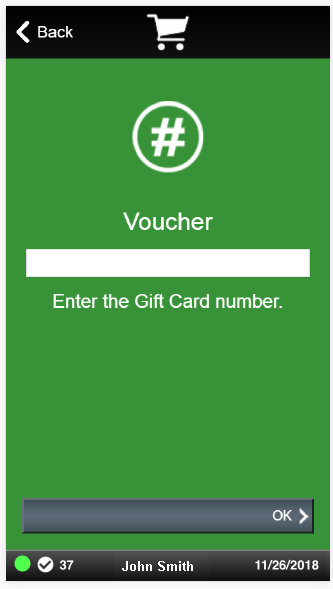6 Processing Tenders
Tendering is the last step that occurs just before completing a sale. You must select a form of payment or refund, and it may involve check or credit card authorizations, if any of these tender types are selected.
For all tender types, you must select or enter two basic items of information:
-
Form of payment (also called tender type; that is, cash, check, credit card, and so on)
-
Amount paid for each selected tender type
Depending upon the form of payment and your system's requirements, you may have to enter or select additional information, for example:
-
Additional tender types if the first tender type did not pay the total due
-
Additional forms of customer ID (driver's license number, birth date, credit card number, hotel guest's room number, or other ID)
-
Customer name
-
Customer address
-
Security approval for large sales or refunds
This section covers the following topics:
Selecting Tenders
The exchange of tender for merchandise or the remitting of a tender for a return is the final step in a transaction. To select a tender for a transaction:
When you are ready to complete the transaction, press Amount Due to list the tenders that are available for the type of transaction you are processing.
Sale Tenders
The following tender types are available on the Xstore POS:
-
House Account (Not available on Handheld)
To tender a transaction:
Figure 6-1 Xstore POS Sale Screen
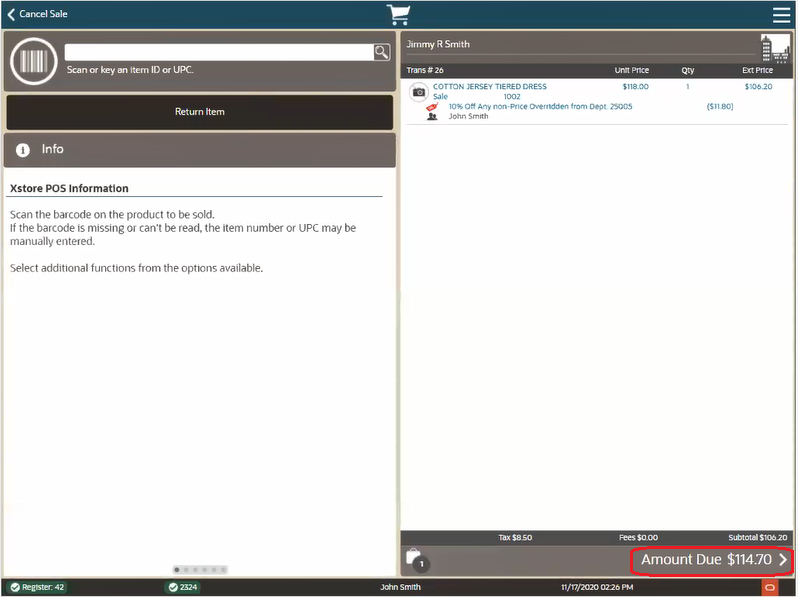
Figure 6-2 Handheld Sale Screen
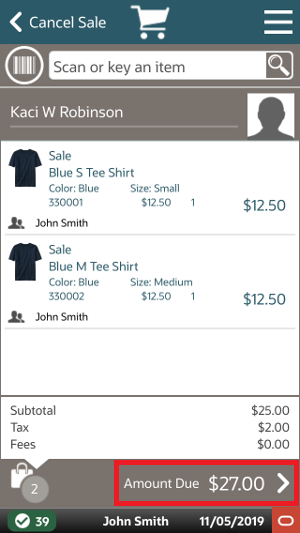
-
Select the Amount Due area to begin transaction tendering.
Figure 6-3 Xstore POS Sale Tender Options
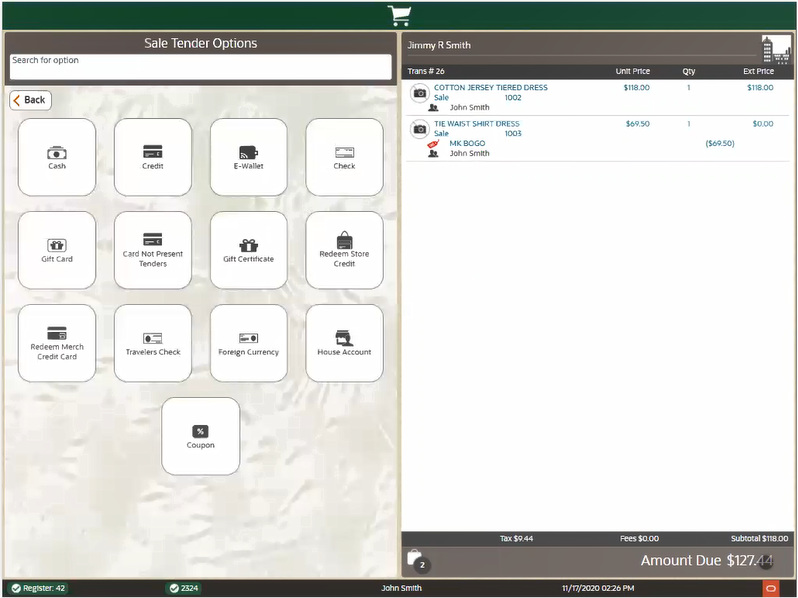
Figure 6-4 Handheld Sale Tender Options
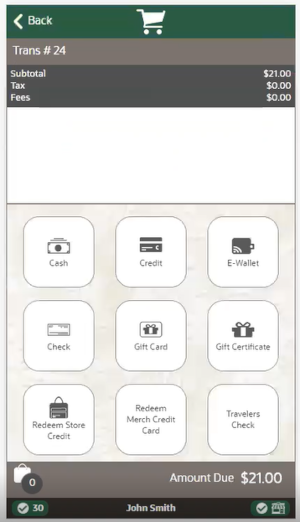
Note:
Your tender list may be different form the example shown here.
-
Select the proper tendering method. To tender a sale, refer to the section for the appropriate tender type as indicated below:
Table 6-1 Tender Types
Tender Type Refer to Cash
Credit
Credit Card, and Debit Card
E-Wallet
Check
Gift Card
Gift Certificate
Redeem Store Credit
Redeem Merch Credit Card
Travelers Check
Foreign Currency
House Account
Coupon
Customer/Card Not Present
Cash
Cash is one type of tender that can be exchanged for merchandise. Networked cash drawers are available and requires you to scan the drawer to confirm you are in front of the cash drawer. Scanning the cash drawer is required when the drawer will need to open as in collecting cash.
-
When all items have been entered or scanned, select Cash.
Figure 6-5 Xstore POS Cash Tender
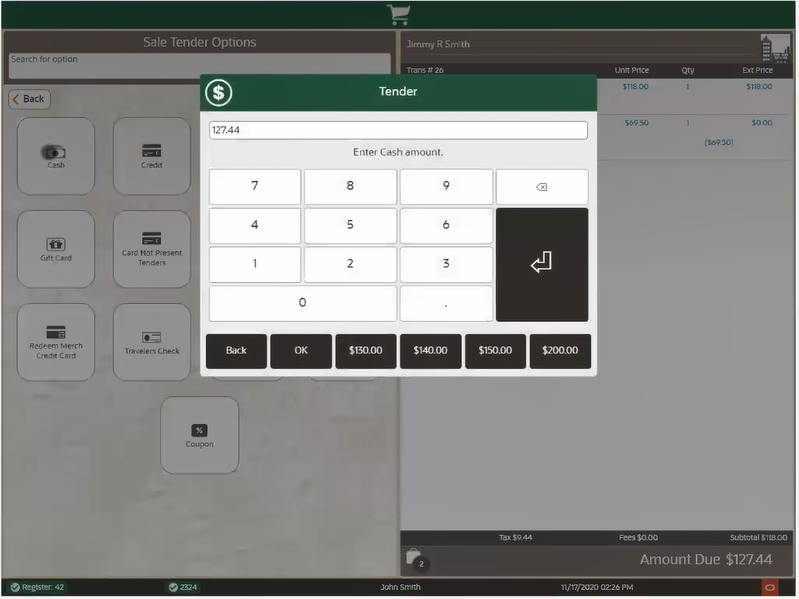
Figure 6-6 Handheld Cash Tender
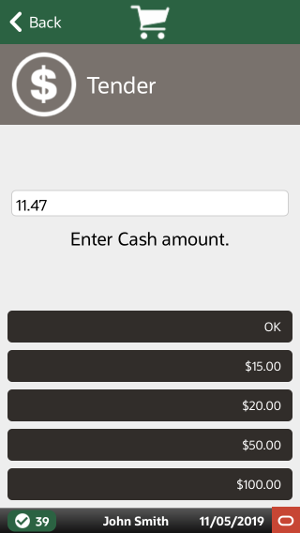
Note:
Depending upon the configuration of your system, the Cash Amount Due prompt may default to the total amount owed for the transaction.
-
Enter the amount of cash presented by the customer and then press OK.
Enter dollar amounts.
<OR>
Choose one of the Quick Cash options.
A prompt may display asking if the sale is complete.
-
Select the method for providing the receipt:
Figure 6-7 Xstore POS Receipt Options
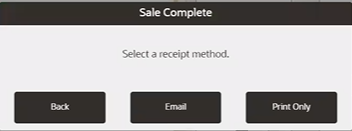
Figure 6-8 Handheld Receipt Options
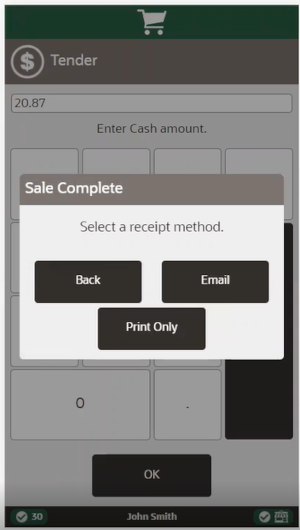
-
Click Email to email the receipt and, if necessary, also provide a printed copy.
-
Click Print Only to provide only a printed copy. The transaction ends.
Figure 6-9 Xstore POS Email Address Prompt

Figure 6-10 Handheld Email Address Prompt
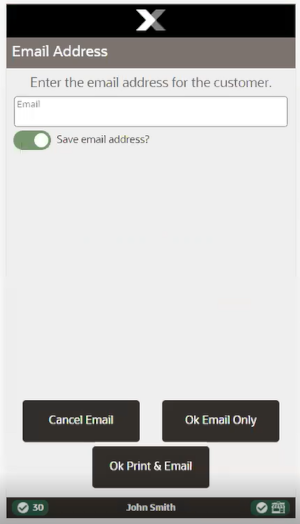
-
-
If you selected an email receipt, enter the customer's email address.
-
When you complete the sale, Xstore POS opens the cash drawer. You can accept money from the customer, place it in the cash drawer and return the change due amount, if the total of all tenders exceeds the amount due.
Xstore POS supports networked cash drawers. Scanning the cash drawer is required when the drawer will need to open as in collecting cash. This confirms you are in front of the cash drawer when it opens.
Figure 6-11 Close Register Prompt

If configured, a prompt displays reminding you to close the cash drawer. After the cash drawer has been closed, the sale receipt is printed, and the system is ready for the next transaction.
The receipt indicates that the purchase was paid with cash, shows the amount tendered, the change amount, and the tender type received.
Figure 6-12 Customer Sale Receipt - Cash Tender Example

Credit Card
Note:
This section applies to Credit and Debit Cards. Both are supported by Oracle Retail EFTLink.
Payment Terminals
You can read credit and debit cards on a PIN Entry Device (PED) payment terminal. The entry modes available are governed by the payment terminal capabilities and payment processor, plus also the transaction amount. The possible entry modes on the payment terminal include:
-
Dip (Insert) the card: Chip and PIN (or Chip and Signature)
-
Card Swipe in the MSR (Magnetic Stripe Reader)
-
Tap the card: NFC Tap & Go
Note:
NFC enabled smartphones can also be used to perform an NFC Tap payment if the payment terminal allows, using payment apps such as ApplePay, SamsungPay and GooglePay.
Figure 6-13 Card Read Prompt
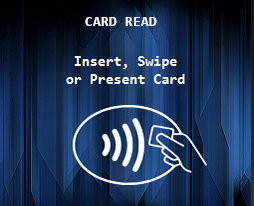
Note:
The payment terminal itself will decide on the authentication required, and can be influenced based on:
-
the country
-
the card type
-
the card entry mode
-
the recent card usage
-
other criteria as determined by the payment provider
When card payments are made using Dynamic Currency Conversion (DCC) on the payment terminal, that is when the payment terminal allows you to pay in foreign currency instead of local currency, the foreign currency information such as foreign currency amount and foreign currency exchange rate is captured.
QR Code
You may need to select a payment terminal if multiple PEDs are in use in the store.
Figure 6-14 Scan Payment Device
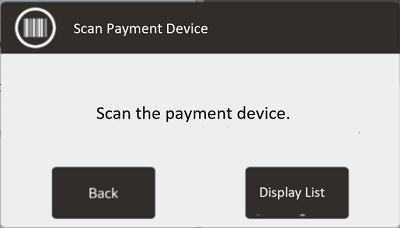
Selection is either by:
-
scanning the QR code on the front of the payment device or,
-
use your device camera or,
-
by selecting from a list of PED devices.
If only one PED is available, no selection of payment terminal is required and the scanning QR code functionality configuration should be disabled.
To select a payment terminal from a QR code:
-
Select a tender type requiring a need of a payment terminal that is authorized by Oracle Retail EFTLink such as a credit/debit card.
-
From the prompt 'Please scan the payment device':
-
Scan the QR code on the front of the payment terminal or,
-
Select the barcode icon (shown on the top left of the PED Selection list to open the device camera and scan the QR code on the front of the payment terminal.
Xstore will send a card service request to EFTLink specifying the PED to use and payment is completed at the scanned PED.
-
Note:
Retailers are responsible for creating QR codes for the payment terminals and placing them on the appropriate device. They are also responsible for configuring available PEDs.
Tendering
To tender a transaction with a credit card:
-
Select Credit from the list of Sale tenders. See Figure 6-3 and Figure 6-4.
Select a payment terminal to use, if required.
Figure 6-15 Xstore POS Credit

Figure 6-16 Handheld Credit
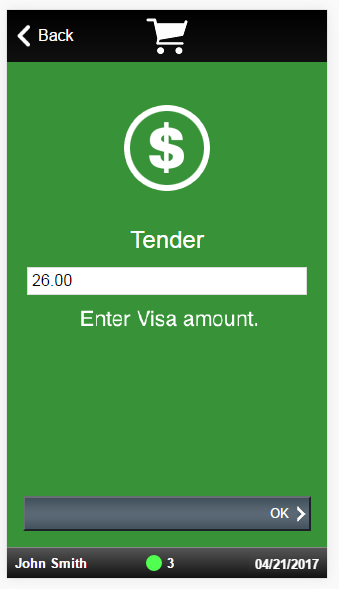
-
Enter the tender amount. Default value is the total for the transaction.
-
Select OK.
Note:
When tendering a transaction with a prepaid credit card, if the amount remaining on the customer's prepaid card is less than the amount owed, the transaction is credited with the remainder of the prepaid card balance. Another tender is then required to complete the sale. If the transaction is canceled, the original amount is returned to the prepaid card.
-
The tender amount is displayed onto the Payment Terminal.
Figure 6-17 Payment Terminal
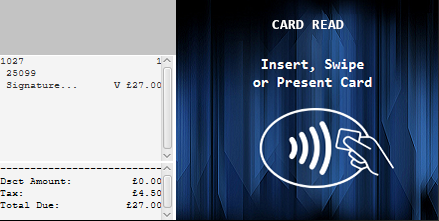
-
The customer will present the payment card using the desired method.
-
Payment Terminal attempts to authorize the tender.
-
If authorization is successful, continue the transaction.
-
If authorization fails, either use a different tender, or continue with Tender Authorization.
-
-
The customer may be prompted by the Payment Terminal to authenticate the card payment:
-
If necessary, wait for the customer to enter their PIN.
-
If necessary, wait for the customer to sign the signature capture device.
-
If necessary, verify the customer signature.
Figure 6-18 Authorization Signature

-
-
After the customer signs, select Accept.
Note:
If your store issues email receipts, additional/different prompts display. Refer to Basic Transaction Entry, Basic Transaction Entry, for more information about E-mail Receipt Options.
-
If necessary, ask the customer to sign the receipt.
Figure 6-19 Receipt Signature Prompt
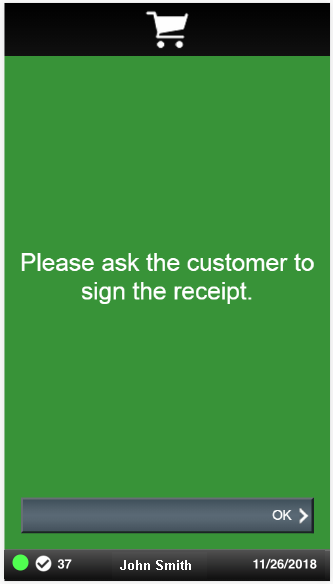
-
If there is still an outstanding balance to pay, then the Sale Tender Options screen is re-displayed for the cashier to select another tender.
-
Select the method for providing the receipt:
-
Click Email to email the receipt and, if necessary, also provide a printed copy.
-
Click Print Only to provide only a printed copy. The transaction ends.
-
-
If you selected an email receipt, enter the customer's email address.
The transaction is complete.
E-Wallet
Digital Wallets (E-Wallets) are new payments methods typically implemented using digital wallet apps on smartphones. PayPal, Alipay, and WeChat Pay are three of the largest providers, but numerous other brands also exist.
Xstore POS supports E-Wallet payments such as PayPal, Alipay, and WeChat Pay, including the ability to void and refund these E-Wallet payments. This functionality is supported in the OPI core of Oracle Retail EFTLink.
Note:
Paypal can also be supported using direct integration to PayPal, via the PayPal core of Oracle Retail EFTLink.
The actual E-Wallet types available to be selected, is determined by the types that the Payment Provider supports, and what types are required by the retailer.
To tender a transaction with an E-Wallet tender:
-
Select E-Wallet in the menu of tenders. See Selecting Tenders.
-
Depending on the number of wallet types available, you may be prompted to select the required E-Wallet type such as PayPal, Alipay, and WeChat Pay and so on.
Figure 6-20 E-Wallet Tender
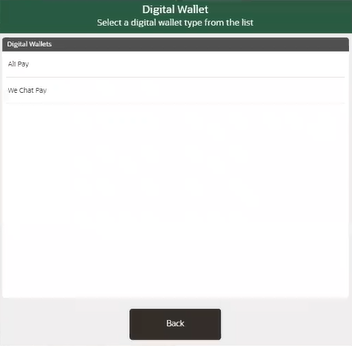
-
Xstore prompts the cashier to scan the QR Code displayed on the shopper’s phone.
-
If the customer has a QR Code displayed in the E-Wallet app on their phone, then the cashier will scan the QR Code.
Figure 6-21 Scan QR Code Prompt
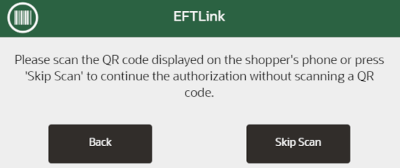
Note:
An advantage of this flow is that the customer's phone does not need to have an internet connection in order to work.
If not, then the cashier will select to Skip Scan.
Note:
For this method, the customers phone must have an internet connection.
-
Confirm the amount to be tendered (usually the full transaction amount) or key a different amount.
If the cashier selected to Skip Scan:
-
The Payment Terminal will display the amount to pay, and a QR Code and prompt the customer to scan the E-Wallet QR Code, on their mobile phone.
-
Wait for the customer to scan the QR Code.
The customer then completes the payment using the E-Wallet app on their mobile phone.
The Payment Terminal either Approves or Rejects the payment.
-
-
If there is still an outstanding balance to pay, then the Sale Tender Options screen is re-displayed for the cashier to select another tender.
-
The Sale Complete prompt is displayed, and the cashier is prompted to select a receipt method.
-
The cashier can select to email or to print the receipts as the Xstore configuration dictates.
Xstore completes the transaction.
Check (Personal)
A personal check is a type of tender that can be exchanged for merchandise. Depending upon your store policy, the prompts for additional tender information may be different from the prompts shown here. These prompts display when a MICR is not available, or if your store policy requires additional information for check processing.
-
After all items have been entered or scanned, select the Check option and then press OK.
Note:
Note: After selecting the Check option from the Sale Tender list, the system may automatically prompt you to place the check in the MICR device. After the system gets the required information from the check, other on-screen prompts may follow, depending on your system's configuration. If the MICR fails to read the check information, the system may display a prompt that allows you to reinsert the check and try again or disable the device and enter the information manually. Disabling a device may require a particular security level.
-
If prompted, enter the check's MICR number (Route number + Account number + Check number) and then press OK.
Figure 6-22 Xstore POS Check MICR Number Prompt
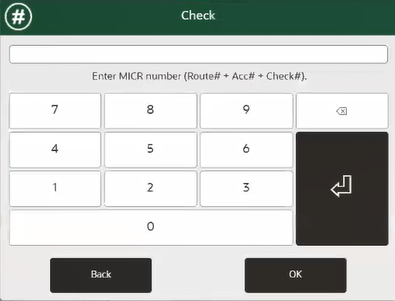
Figure 6-23 Handheld Check MICR Number Prompt
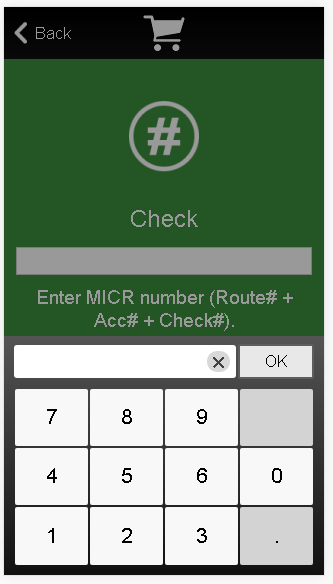
Note:
The entry must consist of a single string of characters with no other embedded spaces or additional characters.
-
If prompted, enter the check number and then press OK. It must be the same check number that you entered when the system prompted for the MICR number.
Figure 6-24 Xstore POS Check Number Prompt
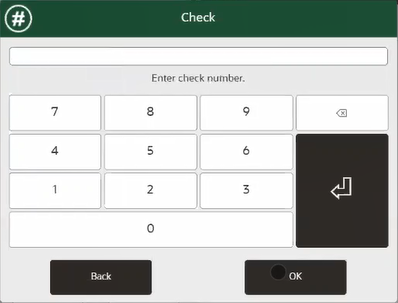
Figure 6-25 Handheld Check Number Prompt
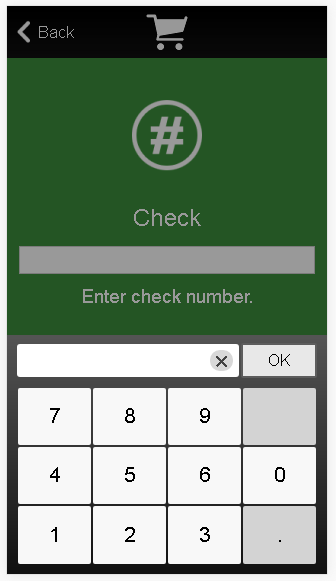
-
If prompted, enter the state from which the customer's ID was issued and then press OK.
Note:
Enter only the two-letter abbreviation for the state.
Figure 6-26 Tender State Prompt
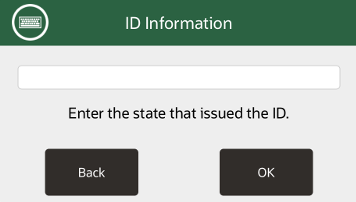
-
If prompted to enter the customer's driver's license number, a credit card number, or other form of ID, enter the ID number and then press OK.
Figure 6-27 ID Prompt
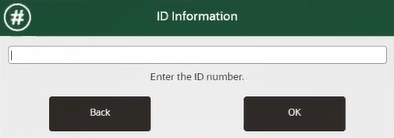
-
If prompted, enter the customer's birth date (as printed on the state-issued ID card) in the MM/DD/YYYY format and then press OK.
Figure 6-28 Check Birth Date Prompt
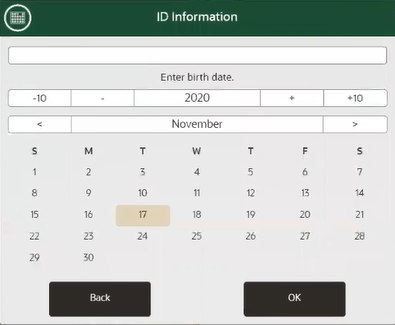
Select Yes to validate the birth date.
Figure 6-29 Birth Date Validation

-
Enter the check amount, or accept the default amount for the total due, and press OK.
Figure 6-30 Check Amount Prompt
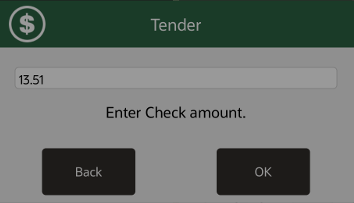
-
If the tender authorization is currently offline, a message displays prompting you to perform one of the following activities:
Figure 6-31 Tender Authorization Offline Prompt
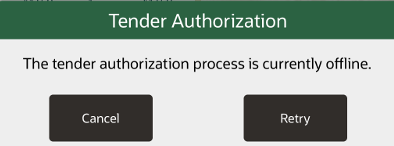
-
Select Cancel to re-tender with another tender type. Xstore POS returns to the tender list where you can select a different tender type.
-
Select Retry to attempt to process the check again.
-
Select Manual to begin the manual authorization process.
If you chose to authorize the card manually, follow the instructions on the prompt and enter the authorization number in the Authorization Number field. Select OK to continue.
-
-
After the information is processed, the system displays a prompt asking if the sale is complete. Press Y for Yes to continue and complete the sale. If you press N for No, Xstore POS returns to the Sale Tender screen.
Note:
If your store issues e-mail receipts, additional/different prompts display. Refer to Basic Transaction Entry, Basic Transaction Entry, for more information about E-mail Receipt Options.
Gift Card
To tender a transaction with a gift card
-
Select Gift Card from the list of Sale tenders. See Figure 6-3 and Figure 6-4.
Enter the card information by doing one of the following:
Swipe the card on the Xstore POS device or enter the card manually. See Manual Entry.
Figure 6-32 Xstore POS Gift Card
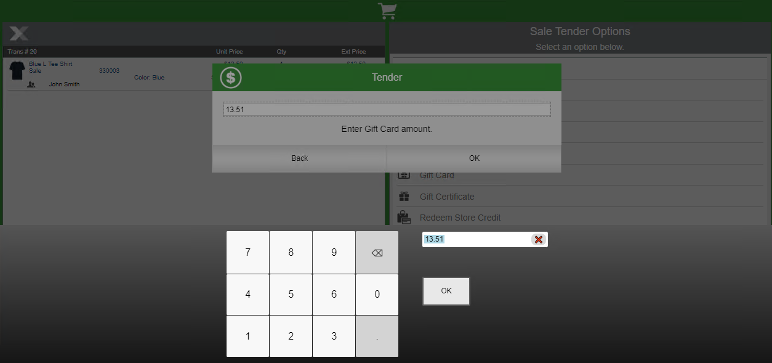
Figure 6-33 Handheld Enter Gift Card Amount
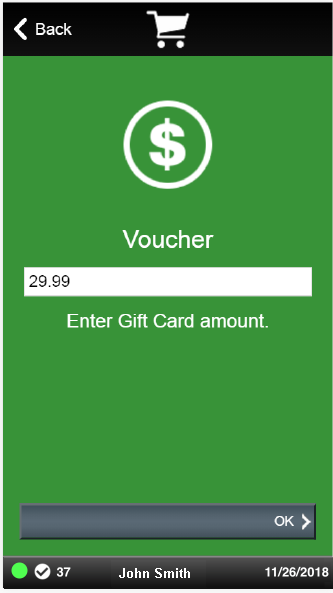
-
If necessary, change the amount to tender on the gift card.
-
Select OK.
Xstore POS attempts to authorize the tender.
-
If authorization is successful, continue the transaction.
-
If authorization fails, either use a different tender, or continue with Tender Authorization.
Note:
If your store issues email receipts, additional/different prompts display. Refer to Basic Transaction Entry, Basic Transaction Entry, for more information about E-mail Receipt Options.
-
The transaction is complete. Return to the Main Menu.
Gift Certificate
To tender a transaction with a gift certificate:
-
Select Gift Certificate from the list of Sale tenders. See Figure 6-3 and Figure 6-4.
Figure 6-35 Gift Certificate Tender
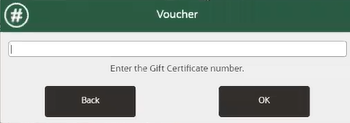
Enter the gift certificate number information by doing one of the following:
Swipe the certificate on the Xstore POS device or enter the gift certificate number.
-
Enter the amount to tender.
-
If the gift certificate value is less than the total due, return to the tender selection screen to select another tender.
-
If the gift certificate is worth more than the amount of the purchase, a store credit, gift card, cash, or other tender is issued as change for the remaining balance, depending upon your store's policy.
-
The transaction is complete. Return to the Main Menu.
Redeem Store Credit
To tender a transaction by redeeming store credit:
-
Select Redeem Store Credit from the list of Sale tenders. See Figure 6-3 and Figure 6-4.
Figure 6-36 Xstore POS Store Credit
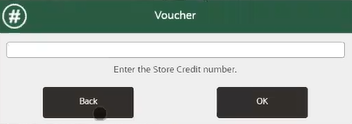
Figure 6-37 Handheld Enter Store Credit Number
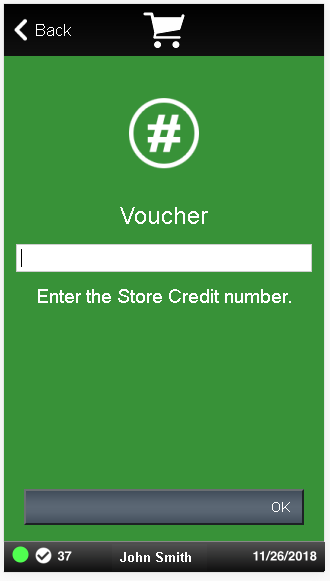
-
Scan the store credit receipt or enter store credit number.
-
Select OK.
-
Select the method for providing the receipt.
-
Click Email to email the receipt and, if necessary, also provide a printed copy.
-
Click Print Only to provide only a printed copy.
-
-
If you selected an email receipt, enter the customer's email address.
The transaction is complete. Return to the Main Menu.
Redeem Merchandise Credit Card
To redeem a merchandise credit card:
-
Select Redeem Merch Credit Card in the menu of tenders.
Figure 6-38 Merchandise Credit Card Tender

-
Enter the merchandise credit card number:
-
Scan the merchandise credit card or,
-
Enter the merchandise credit card number.
-
-
If prompted, select Yes to complete the transaction.
Traveler's Check
A traveler's check is a type of tender that is issued to an individual by a financial institution and can be exchanged for merchandise. Traveler's checks are issued in set denominations.
-
Select Traveler's Check in the menu of tenders.
Figure 6-39 Traveler Check Tender
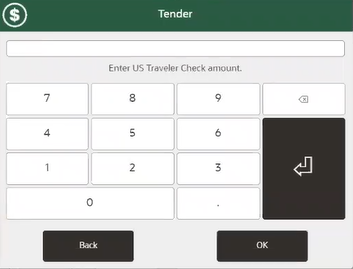
-
Enter the traveler's check amount and select OK.
Note:
Traveler's checks are issued in specific and pre-determined denominations. The system displays a message if you enter an invalid amount for this tender type.
-
If the traveler's check value is less than the total due, return to the tender selection screen.
-
If the traveler's check is worth more than the amount of the purchase, a store credit, gift card, cash, or other tender is issued as change for the remaining balance, depending upon your store's policy.
-
Foreign Currency
When sales are tendered in a foreign currency, the amount entered is automatically converted to your local currency. Any change due to the customer displays in local currency. This is known as Dynamic Currency Conversion (DCC).
-
Select Foreign Currency in the menu of tenders. Xstore POS prompts for the type of foreign currency.
Figure 6-40 Foreign Currency Tender
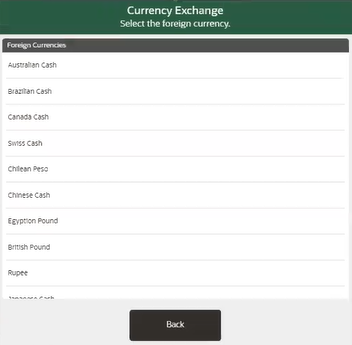
-
Select the foreign currency.
-
Enter the currency amount or use one of the Quick Cash buttons. The foreign currency amount is converted to local currency for display in the View Port.
-
If prompted, select Yes to complete the transaction.
-
If prompted, scan the cash drawer you are using. The cash drawer opens. If configured, a prompt displays reminding you to close the cash drawer.
-
Close the cash drawer. After the cash drawer has been closed, the sale receipt prints, and the system is ready for the next transaction.
House Account
Note:
Handheld does not support house account.
To tender a transaction with a house account:
-
Select House Account in the menu of tenders.
-
If there is no customer assigned to the transaction, you are prompted to add one. Click Yes if prompted.
-
If the customer does not have an active house account set up, this tender will not be available.
-
If a house account payment is part of the sales transaction, the House Account tender option will not be available.
-
If the customer's house account has been closed, this tender is not available.
-
If the customer's house account is on hold, this tender is not available.
Xstore POS displays a list of authorized buyers associated with this house account.
-
-
Select the authorized buyer from the list.
-
If necessary, change the amount to tender on the house account.
-
If the amount to tender exceeds the account limit:
-
If the amount is within the override limit, Xstore POS opens a prompt. Click Yes to use the house account tender and continue the transaction.
-
If the amount exceeds the account limit and is greater than the override limit, the transaction cannot be tendered for the full amount using the house account. Click OK to close the prompt and change the amount to apply to the house account.
-
-
If prompted, ask the customer to sign on the PIN pad device.
-
Verify the customer's signature.
-
If prompted, select Yes to complete the transaction.
Coupon
To redeem a coupon tender:
-
Select Coupon in the menu of tenders.
-
Enter the coupon ID:
Figure 6-41 Scan Coupon ID
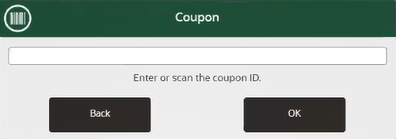
-
Scan the serial number or,
-
Enter the serial number.
-
-
Depending upon the coupon type, you may be prompted to enter the coupon value. If prompted, enter the coupon amount.
Figure 6-42 Coupon Amount

-
Xstore POS applies the coupon to the transaction:
-
If the coupon is worth more than the amount of the purchase, a store credit, gift card, cash, or other tender is issued as change for the remaining balance, depending upon your store's policy.
-
If the coupon does not cover the entire amount of the purchase, the screen automatically returns to the tender selection screen.
-
-
If prompted, select Yes to complete the transaction.
Room Charge Tender
A room charge is a tender type used in hotels. Select the Room Charge tender option in a sale transaction to apply the total of the transaction to the guest's room bill.
-
Select Room Charge in the menu of tenders. A Guest Lookup form opens.
-
Enter lookup information in any one of the fields:
-
Room #: Guest room number
-
Guest Name: Full name of the guest.
-
Guest #: ID number for the guest.
-
-
Select Process. Xstore POS displays a list of customers matching the search information.
-
Select the guest's name in the list.
-
If necessary, change the amount to the charged to the guest's room bill.
-
If prompted, ask the guest to sign for the room charge and complete the sale transaction.
The receipt will indicate that the purchase was charged to the guest's room bill and shows the amount tendered.
Customer Not Present Payments
Customer/Card not present (CNP) payments allows for customers to make card payments over the phone, which can be useful for accepting telephone orders at the store. Three different methods can be available, if configured:
-
-
Customer speaks their card details over the phone to the cashier
-
Cashier manually keys the card details into the payment terminal
-
-
-
If customer has payment card details saved against their customer account, then these payment cards can be used
-
The customer must be attached to the transaction for this payment method to be available
-
The customer must have selected to Save Payment Cards for future use in Customer Maintenance
-
The payment provider must be configured to return Card Tokens to Xstore, when the customer makes card payments, and these card tokens have been saved against the customer account in Xstore
-
This method is faster, more secure and less error prone than the first method above
-
-
Pay By Link (Customer Not Present)
-
Customer is emailed a PBL link, which they click and complete the payment on the Payment Providers secure web checkout page
-
The customer can select any payment method offered by the payment provider, and could include E-Wallets, Gift Cards, BuyNowPayLater, On-line banking, as well as the traditional Credit/Debit cards
-
The payment provider sends a notification to Xcenter with details of the payment made by the customer
-
Xstore periodically collects these payment details from Xcenter, and updates the payment details against the customer’s order/account
-
Note that this payment method could complete minutes, hours or even days later, and is currently only available in Send Sale Transactions and Local Inventory Orders. The transactions tendered with PBL that are awaiting payment or are automatically voided due to the PBL expiring, are listed in the Messages Tab on the home screen.
-
Again, this method is more secure than the first method above, and also provides a large number of payment options for the customer
-
The tenders may be held within a Customer and Card Not Present sub-menu of tenders or may alternatively be in the top-level tenders menu.
Credit/Debit Card Not Present
-
Select Credit/Debit Card Not Present tender. Select a payment terminal to use, if required.
Figure 6-43 Customer Not Present Tender
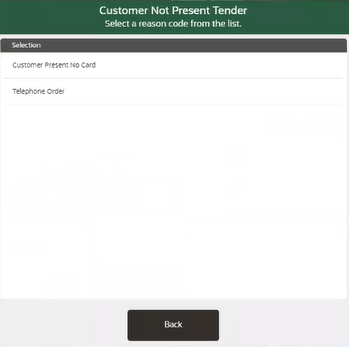
-
Select a reason for using this tender.
-
Confirm the tender amount. Default value is the total for the transaction.
-
Enter the card data requested into the payment terminal. Firstly, the primary account number, and then the card expiry date, and finally, the CVV.
-
Confirm the purchase amount and the card payment is authorized (or declined) by the payment terminal.
Saved Payment Cards
-
Select Saved Payment Cards tender.
Figure 6-44 Saved Payment Cards

-
Confirm the payment card that the customer wishes to use.
-
The cashier should ask the customer for the Card Type and last four digits.
-
Only the Card Type and last four digits of the card number will be displayed, and if a matching saved payment card is found, then the cashier should select this card.
-
-
Select a reason for using this tender.
-
Enter the tender amount. Default value is the total for the transaction.
-
Xstore sends the request to pay by the selected cards Card Token to EFTLink.
-
The payment terminal authorizes (or declines) the payment.
Pay By Link (Customer Not Present)
Only available in Send Sale Transactions and Local Inventory Orders. This tender type allows for customers not physically in the store that would like to purchase items, pay for them in full without giving their card details over the phone, and either pick up (Local Inventory Orders) the items or have them shipped (Send Sales).
-
Select Pay By Link (Customer Not Present) tender.
-
Select a reason for using this tender.
-
Confirm the tender amount. Default value is the total for the transaction and this value cannot be changed, since split tendering cannot be performed when using Pay By Link (Customer Not Present).
-
Xstore sends a message to EFTLink to request a PBL link (url) from the Payment Provider. A PBL link is returned to Xstore.
-
Xstore sends an email to the customer, containing the order details and amount, plus the PBL link for making the payment. Also included is the expiry date/time of the link, after which the customer can no longer make the payment.
-
Xstore completes the PBL payment and sets the status of the order/account to Awaiting Payment.
-
The customer clicks the link in the email and completes the payment at their leisure, on the payment providers secure checkout webpage, using their selected payment method.
The transaction cannot be processed (send sale can't be shipped and local inventory order can't be picked/reserved) until the payment has been made by the customer using PBL. The customer is given a set amount of time to make the payment and if the payment is not made before the expiration date, Xstore is informed, and the transaction is automatically voided.
Note:
Please be aware that the void process is not supported in fiscal countries.
The Awaiting Payment status is used when the transaction has not yet been paid for by the customer. A send sale in this status will not be available for creating the shipping documents for shipping and the local inventory order cannot be picked/reserved in this status.
Voided and Awaiting Payment notifications can be found in the Messages Tab on the home screen in Xstore.
Figure 6-45 Payment Methods
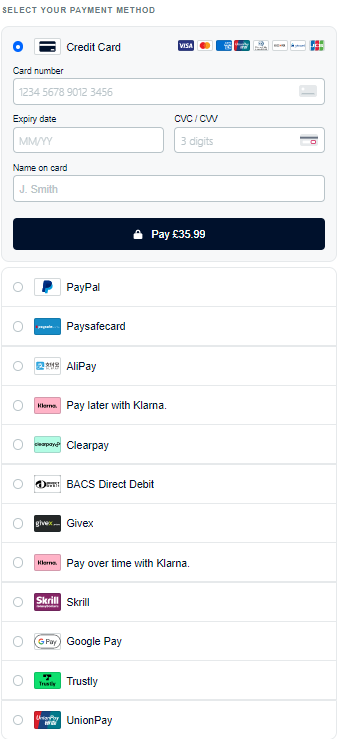
-
Xstore periodically retrieves completed PBL payments from Xcenter and sets the order/account to be completed.
-
It’s also possible for PayByLink to be configured to execute on the payment terminal, for customer present payments
-
This tender is called Pay By Link
-
The customer is in the store and requests to pay using an on-line payment method (that is accepted using the PayByLink on the payment terminal)
-
Note that whilst this can provide some additional payment methods for the customer to use, there are some limitations with this form of PayByLink
-
The available payment methods are likely to be a lot less than for the PBL (Customer Not Present)
-
It will likely increase the time at the checkout
-
It will not be available if the customer does not have an internet connection on their mobile phone
-
It does not support tipping and currency conversion
-
Pay By Link (Customer Present)
-
Select Pay By Link tender.
-
Confirm the tender amount. Default value is the total for the transaction.
-
Payment terminal displays QR code representing the PBL link.
-
Customer scans the QR code with their mobile phone, which takes the customer to the payment providers secure checkout webpage.
-
Customer completes payment using their preferred payment method.
-
On completion of payment, the payment terminal shows Approved (or Declined), and Xstore completes the tender.
Tender Authorization
If an attempt to authorize a tender fails, perform one of the following procedures to continue with the same tender:
Retry Authorization
To attempt the authorization again:
Troubleshoot the connection to the authorizer.
-
Check the network connection for the Xstore POS server.
-
Check whether the Xstore POS server can connect to the internet.
Figure 6-46 Xstore POS Tender Authorization Offline Prompt

Figure 6-47 Handheld Tender Authorization Offline
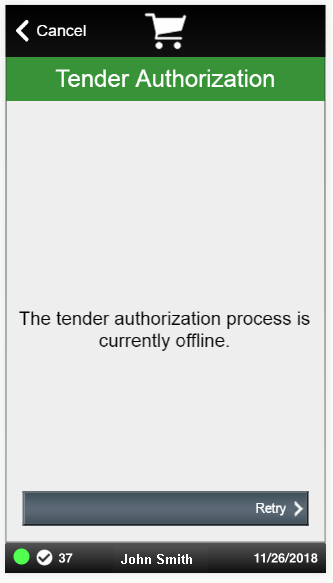
-
Select the Retry button.
If the retry is successful, continue the transaction.
If the retry fails, either perform another retry, or continue with Manual Authorization.
Manual Authorization
It’s possible that the Payment Terminal will sometimes request a "manual authorization" from the cashier on the POS.
Note:
Call the appropriate authorization provider to manually authorize a tender. Xstore POS does not provide manual authorization numbers.
To enter manual authorization information:
-
Select the Manual button.
Figure 6-48 Enter Authorization Code
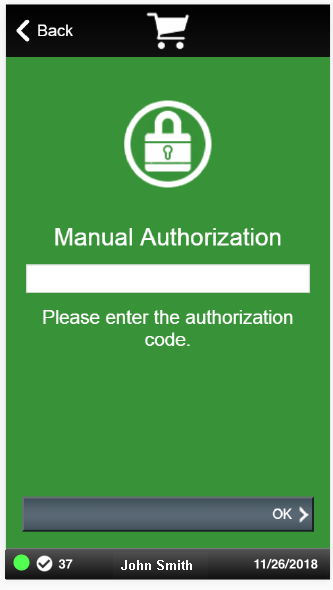
-
Enter the authorization number.
-
Select OK.
Continue the transaction.
Return Tenders
To select a return tender for a refund transaction:
-
Click Add Tenders when you are ready to complete the transaction.
Xstore POS displays a list of return tender types. The list of return tenders available for issuing refunds will be determined by type of return (verified or unverified / blind return) and the Xstore configurations for return tenders.
Over tendering a refund is not allowed.
Figure 6-49 Return Tender Options
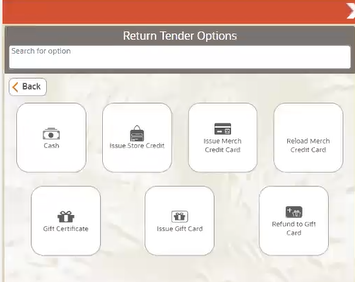
Examples of return tender types:
-
To tender a refund, select the tender required.
Cash
To tender a return transaction in cash:
-
Select Cash in the menu of tenders.
-
Enter the amount of cash to be returned to the customer and click OK:
Figure 6-50 Cash Return
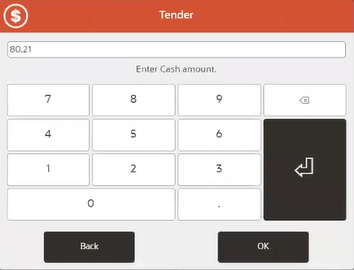
-
If prompted to complete the transaction:
-
Click Yes to complete the transaction.
The transaction completion process begins.
-
Click No to return to the tender selection screen. See Selecting Tenders.
-
-
If prompted, scan the cash drawer you are using.
The cash drawer opens. If configured, a prompt displays reminding you to close the cash drawer.
-
Take the cash from the cash drawer and return it to the customer.
-
Close the cash drawer.
After the cash drawer has been closed, the sale receipt prints, and the system is ready for the next transaction.
Credit/Debit Card
The procedure for tendering a return on a credit/debit card will change depending upon whether the card is selected from the Selecting Tenders list, or if it is automatically selected by a verified return:
Select from the List of Tenders
To tender a return with a Credit Card selected from the Selecting Tenders list:
-
Select Credit/Debit in the menu of tenders. See Selecting Tenders.
-
Confirm the amount to be refunded (usually the full transaction amount) or key a different amount.
Figure 6-51 Credit Return

-
The tender amount is displayed onto the Payment Terminal.
Figure 6-52 Payment Terminal

-
The customer will present the payment card using the desired method.
-
It’s possible that the Payment Terminal will sometimes request a "manual authorization" from the cashier on the POS.
-
Call the authorizing agent to request and receive an authorization code.
-
Enter the authorization code.
-
Click OK.
The Manual Authorization code is transmitted to the Payment Terminal for approval.
-
-
The customer may be prompted by the Payment Terminal to authenticate the card payment:
-
If necessary, wait for the customer to enter their PIN.
-
If necessary, wait for the customer to sign the signature capture device.
-
If necessary, verify the customer signature.
-
-
If necessary, ask the customer to sign the receipt.
-
The Payment Terminal either Approves or Rejects the refund.
-
If there is still an outstanding balance to refund, then the Return Tender Options screen is re-displayed for the cashier to select another tender.
-
The Sale Complete prompt is displayed, and the cashier is prompted to select a receipt method.
-
The cashier can select to email or to print the receipts as the Xstore configuration dictates.
Xstore completes the transaction.
Automatically Selected Credit Card
Automatically displays the credit card information for the original transaction when you tender a verified return. To tender the return:
-
Select the return tender:
-
Click OK to apply the tender to the card used in the original transaction. This is called a tokenized refund and uses the saved transaction token on Xstore from the original card payment, and thus the customer does not need to re-present the card. Continue with Step 2.
-
If the original card is not suitable to be used, for example it has expired, or a different card or tender is required, click Back to change tenders. Continue with Selecting Tenders.
-
-
Confirm the amount to be refunded or key a different amount (cannot refund a higher amount that was originally tendered on this card).
-
If necessary, ask the customer to sign the receipt.
-
The Payment Terminal either Approves or Rejects the refund for the verified refund.
-
If there is still an outstanding balance to be refunded, then the Return Tender Options screen is re-displayed for the cashier to select another tender.
-
The Sale Complete prompt is displayed, and the cashier is prompted to select a receipt method.
-
The cashier can select to email or to print the receipts as the Xstore configuration dictates.
Xstore completes the transaction.
E-Wallet
The procedure for tendering a return on an E-Wallet tender is like that with a Credit / Debit card, that was used as payment on the original sale transaction. It is not possible to perform a blind return to an E-Wallet tender, it can only be selected from the original tenders on a verified return.
Automatically Selected E-Wallet Tender
automatically displays the E-Wallet information for the original transaction when you tender a verified return. To tender the return:
-
Select the return tender:
-
Click OK to apply the tender to the E-Wallet used in the original transaction. This is called a tokenized refund and uses the saved transaction token on Xstore from the original E-Wallet payment, in order to refund to the original E-Wallet account. Continue with Step 2.
-
If the original E-Wallet is not suitable to be used, for example it has expired, or a different tender is required, click Back to change tenders. Continue with Selecting Tenders.
-
-
Confirm the amount to be refunded or key a different amount (cannot refund a higher amount that was originally tendered on this card).
-
If necessary, ask the customer to sign the receipt.
-
The Payment Terminal either Approves or Rejects the refund for the verified refund.
-
If there is still an outstanding balance to be refunded, then the Return Tender Options screen is re-displayed for the cashier to select another tender.
-
The Sale Complete prompt is displayed, and the cashier is prompted to select a receipt method.
-
The cashier can select to email or to print the receipts as the Xstore configuration dictates.
Xstore completes the transaction.
Gift Card
To issue or reload a gift card:
-
Select Issue Gift Card or Reload Gift Card in the menu of tenders. See Selecting Tenders.
Note:
Select the Issue Gift Card option to issue a new gift card. Select the Refund to Gift Card option to put the refund value onto the customer's current gift card.
-
Enter the gift card number:
-
Scan the gift card.
-
Enter the gift card number.
-
-
If necessary, change the amount to refund.
Figure 6-53 Return Gift Card Amount
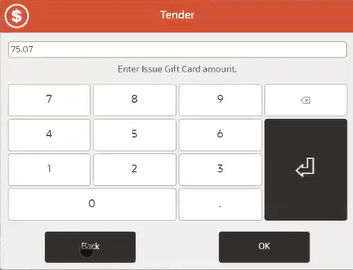
-
If prompted to complete the transaction:
-
Click Yes to complete the transaction.
The transaction completion process begins.
-
Click No to return to the tender selection screen. See Selecting Tenders.
-
Gift Certificate
To issue a gift certificate:
-
Select Gift Certificate in the menu of tenders. See Selecting Tenders.
-
Enter the gift certificate amount.
Figure 6-54 Issue Gift Certificate
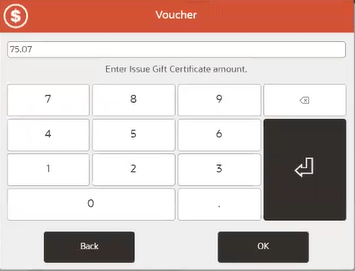
-
If necessary, change the amount to refund.
-
If prompted to complete the transaction:
-
Click Yes to complete the transaction.
The transaction completion process begins.
-
Click No to return to the tender selection screen. See Selecting Tenders.
-
Store Credit
To issue store credit:
-
Select Issue Store Credit in the menu of tenders. See Selecting Tenders.
-
If necessary, change the amount of store credit to issue.
Figure 6-55 Return Store Credit Prompt
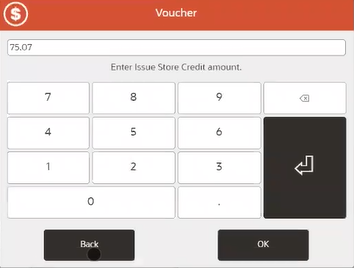
Note:
If the total return amount is greater than the maximum allowed value of store credit to issue, will show the maximum allowed value of store credit.
-
Click OK if prompted sign the store credit voucher.
-
If prompted to complete the transaction:
-
Click Yes to complete the transaction.
The transaction completion process begins.
-
Click No to return to the tender selection screen. See Selecting Tenders.
-
-
If necessary, sign the store credit voucher.
-
Give the customer the store credit voucher along with the receipt.
Merchandise Credit Card
To issue or reload a merchandise credit card:
-
Select Issue Merch Credit Card or Reload Merch Credit Card in the menu of tenders. See Selecting Tenders.
Note:
Select the Issue Merch Credit Card option to issue a new merchandise credit card. Select the Reload Merch Credit Card option to put the refund value onto the customer's current merchandise credit card.
-
Enter the merchandise credit card number:
-
Scan the merchandise credit card.
-
Enter the merchandise credit card number.
Figure 6-56 Return Merchandise Credit Card Numbers

-
-
If necessary, change the amount to refund.
-
If prompted to complete the transaction:
-
Click Yes to complete the transaction.
The transaction completion process begins.
-
Click No to return to the tender selection screen. See Selecting Tenders.
-
House Account
To tender a transaction with a house account:
-
Select House Account in the menu of tenders. See Selecting Tenders.
-
If there is no customer assigned to the transaction, you are prompted to add one. Click Yes if prompted.
-
If the customer does not have an active house account set up, this tender will not be available.
-
If a house account payment is part of the sales transaction, the House Account tender option will not be available.
-
If the customer's house account has been closed, this tender is not available.
-
If the customer's house account is on hold, this tender is not available.
A list of authorized buyers associated with this house account is displayed.
-
-
Select the authorized buyer from the list:
-
Click the buyer.
-
-
If necessary, change the amount to return on the house account.
-
If the amount to tender exceeds the account limit:
-
If the amount is within the override limit, opens a prompt:
-
Click Yes to use the house account tender and continue the transaction.
-
Click No to either use a different tender or apply a smaller amount to the house account and use a different tender for the remainder.
-
-
If the amount exceeds the account limit and is greater than the override limit, the transaction cannot be tendered for the full amount using the house account.
Click OK to close the prompt and change the amount to apply to the house account.
-
-
If prompted, ask the customer to sign on the PIN pad device.
-
Verify the customer's signature.
-
If prompted to complete the transaction:
-
Click Yes to complete the transaction.
The transaction completion process begins.
-
Click No to return to the tender selection screen. See Selecting Tenders.
-
-
If prompted, ask the customer to sign the receipt.
Room Charge
A room charge is a tender type used in hotels. Select the Room Charge tender option to remove the total of the transaction from the guest's room bill.
-
Select Room Charge in the menu of tenders. See Selecting Tenders.
A Guest Lookup form opens.
-
Enter lookup information in any one of the fields:
Note:
Any additional information you enter into another field is ignored.
-
Room #: Guest room number.
-
Guest Name: Full name of the guest.
-
Guest #: ID number for the guest.
-
-
Click Process.
displays a list of customers matching the search information.
-
Select the guest's name in the list:
-
Click the customer.
-
-
If necessary, change the amount to the charged to the guest's room bill.
-
If prompted to complete the transaction:
-
Click Yes to complete the transaction.
The transaction completion process begins.
-
Click No to return to the tender selection screen. See Selecting Tenders.
-
-
When prompted, ask the customer to sign the receipt for the room charge.
Customer Not Present
There are times when customers require a refund but are not present in the store and are likely to be on the phone with the cashier arranging the return/refund.
This can occur in several scenarios, such as:
-
The customer has received damaged, faulty or missing goods and wants to receive a refund over the phone to their Credit/Debit card, without having to visit the store
-
If part of a customer’s order that's has been paid for in full, was due to be received into store for a customer pickup, but either never arrived in store, or perhaps was taking too long, and the customer decided to cancel the item(s)
The refund to a Credit/Debit card may then be required, if for example:
-
The verified refund to the original payment card used on the sale, is failing for some reason, such as the payment card having expired, or the time duration since the payment is longer than that accepted by the payment provider
-
The original sale perhaps did not use a Credit/Debit card, but another form of payment such as cash, check or Gift Card
Credit/Debit (Card Not Present)
-
Select Credit/Debit (Card Not Present) in the menu of tenders.
Figure 6-57 Return Customer Not Present
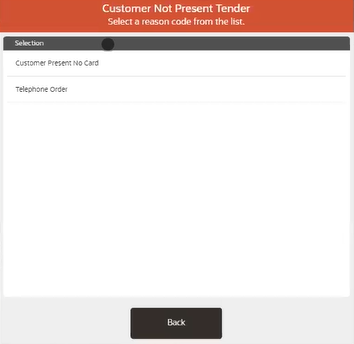
-
Select a reason as to why the customer is not present.
-
Confirm the amount to be refunded (usually the full transaction amount) or key a different amount.
-
Xstore sends a card refund request to EFTLink, indicating that the cardholder is not present.
-
The tender amount is displayed onto the Payment Terminal.
-
The payment terminal prompts the cashier to key the required data such as Card Number, Expiry Date and CVV on the payment terminals keypad.
-
Note that the required data could be different dependent on the payment provider and the region / country
-
-
Request the required data from the customer over the phone.
-
Key the requested data into the payment terminal.
The Payment Terminal either Approves or Rejects the refund.
The Sale Complete prompt is displayed, and the cashier is prompted to select a receipt method.
The cashier can select to email or to print the receipts as the Xstore configuration dictates.
Xstore completes the transaction.
Saved Payment Card
-
If customer has payment card details saved against their customer account, then these payment cards can be used
-
The customer must be attached to the transaction for this refund payment method to be available
-
This method is quicker and more secure than the previous method
-
Select Saved Payment Card in the menu of tenders.
Note that this tender may require supervisor security privilege.
-
Xstore displays a list of Saved Payment Cards and cashier asks customer if they want the refund to one of these cards.
Only the Card Type and last four digits of the card number will be displayed.
-
Select the required Saved Payment Card from the list displayed.
-
Select a reason as to why the customer is not present.
-
Confirm the amount to be refunded (usually the full transaction amount) or key a different amount.
-
Xstore sends a card refund request to EFTLink, indicating the Card Token of the selected saved payment card.
-
The Payment Terminal either Approves or Rejects the refund.
The Sale Complete prompt is displayed, and the cashier is prompted to select a receipt method.
The cashier can select to email or to print the receipts as the Xstore configuration dictates.
Xstore completes the transaction.
Splitting Tenders
A customer may use multiple tenders when paying for an item. To use multiple tenders:
-
Select a method of payment. See Selecting Tenders.
-
Enter the amount to apply to the tender.
-
Follow all prompts for the tender.
-
Repeat Steps 1 to 3 for each tender to apply to the transaction.
Note:
The tender list will continue to display if there is an outstanding balance. You may select as many tender types as necessary to satisfy the balance.
Each tender is listed in its own line.
Figure 6-58 Handheld Showing Spit Tenders
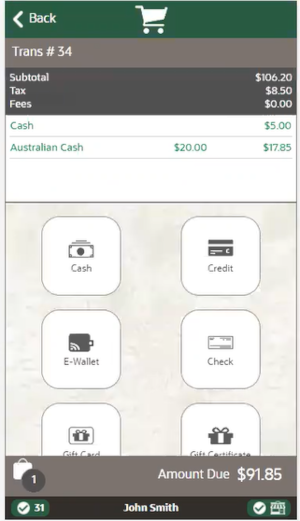
Void a Tender
To void a tender:
-
Select the tender line of the currency to void. The Modify Tender menu is shown.
Figure 6-59 Handheld Modify Tender Menu
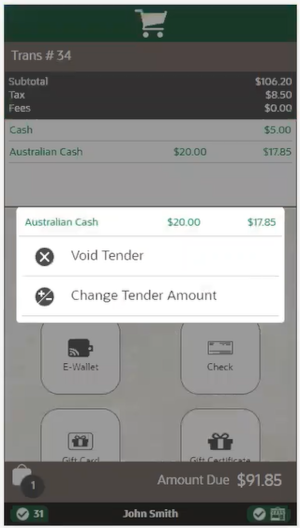
-
Click Void Tender.
The tender is removed from the transaction. Continue to select tenders until the balance is zero.
Figure 6-60 Handheld Tender List

-
When balance is zero, click Complete Sale.
Figure 6-61 Handheld Complete Sale
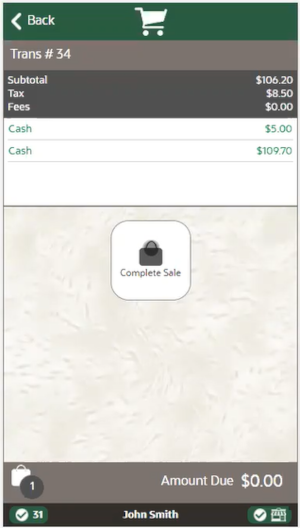
The receipt method prompt is displayed.
Note:
Your system may print receipts without prompting you to confirm that the sale is complete. In that case, the system prints receipts as soon as the total of all tenders selected equals or exceeds the amount due.
Change Tender Amount
To change a tender amount:
-
Select the tender line of the currency to change. The Modify Tender menu is shown.
Figure 6-62 Handheld Modify Tender Menu

-
Click Change Tender Amount.
-
prompts for the new tender amount. Enter the new amount to apply to the tender.
Figure 6-63 Handheld Tender Amount
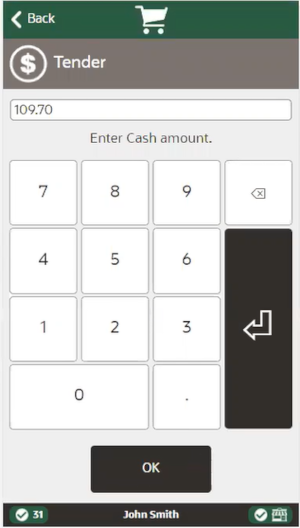
-
Click OK.
Continue to select tenders until the balance is zero.
-
When balance is zero, click Complete Sale.
Figure 6-64 Handheld Complete Sale

The receipt method prompt is displayed.
Note:
Your system may print receipts without prompting you to confirm that the sale is complete. In that case, the system prints receipts as soon as the total of all tenders selected equals or exceeds the amount due.
Currency Rounding
Currency rounding refers to the process of rounding the cost of a purchase (which is to be paid for in cash) to the nearest multiple of the smallest denomination of currency.
Low denomination coins in some currencies were removed from circulation and are no longer available. Because it may not be possible to make exact change for a cash purchase, amounts must be rounded to the lowest available denomination of coinage. For these currencies, automatically applies rounding rules that enforce the minimum denomination value that can be accepted or refunded.
For example, in Australia, the 5-cent coin is the smallest-valued denomination currently in circulation. Because of this, all transaction amounts using Australian currency must be multiples of 5 cents.
When currency rounding is in use, a Cash Total is displayed below the transaction Subtotal. The Cash Total is rounded to the nearest multiple of the Minimum Cash Denomination Value for the currency.
For example, a tender with a Minimum Cash Denomination Value of 5 cents ($0.05) results in the following totals in a sale transaction:
-
If the Transaction Total=$161.44, then the Cash Total is $161.45 (rounded up).
-
If the Transaction Total=$236.51, then the Cash Total is $236.50 (rounded down).
If your system is configured to default to the Amount Due when prompting for a tender amount, the Cash Total amount appears in the Enter Cash Amount text field, where it may be accepted or edited. However, tenders can only be accepted (and refunded in return transactions) in amounts that are even multiples of its Minimum Cash Denomination Value.
These values are also printed on the receipt.
